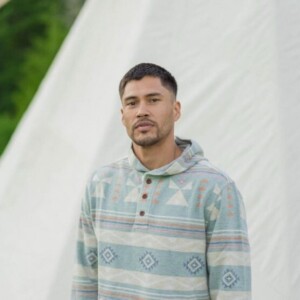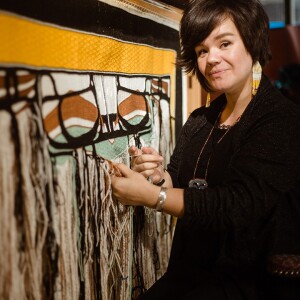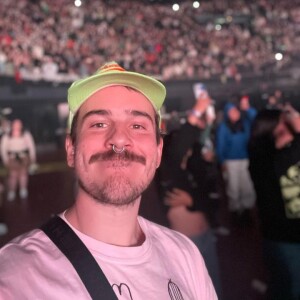Chatter Marks
Chatter Marks is a podcast of the Anchorage Museum, dedicated to exploring Alaska’s identity through the creative and critical thinking of ideas—past, present and future. Featuring interviews with artists, presenters, staff and others associated with the Anchorage Museum and its mission.
Episodes

Sunday Apr 16, 2023
EP 60 Little, wild places with Erin Ggaadimits Ivalu Gingrich
Sunday Apr 16, 2023
Sunday Apr 16, 2023
Erin Ggaadimits Ivalu Gingrich grew up in Galena, Alaska, a place that continues to have an impact on her art. You can see it in her beadwork and the masks and sculptures she creates. They represent — among other things — birds, berries, caribou, seals and fish. In fact, when she thinks back on her childhood in Galena, fish are a big part of her memories. She remembers watching them being caught in fish wheels and by people along the Yukon River. She also remembers being told to be mindful of the river because of what it is — this thing of nature that brings bounty, but can also bring destruction if you’re not careful around it. Overall, she remembers the sense of freedom she felt growing up in such a rural place, being one with nature and with wildlife.
She lives in Anchorage now and talks about the importance of little, wild places. How Alaska is known for its size and its scale — its large, open spaces occupied by trees, grass, mountains and wildlife — but little patches of wilderness are important too. They can be an untamed patch of grass that grows on the sidewalk or a lake in the middle of town. Anything that brings you back to the earth, back to being one with a natural environment.
When Erin thinks about being one with her natural environment, she doesn’t recall one single image. She recalls moments and sounds that create a feeling — like running water or fishing in the rain with her mom. Thinking about this one morning when she and her mom were out dipnetting on the Kasilof River and it was pitch black, there were seals fishing in the water, it was raining and they could see dark clouds on the horizon and an incoming thunderstorm. She says that she felt in-community with the natural elements around her — with the seals and with all the other people who were out fishing.

Monday Apr 03, 2023
Monday Apr 03, 2023
Brothers Garrett and Jake Swenson are part of the hip hop group Brother Buffalo. They’re of Eyak heritage, with roots in Cordova, Alaska, but they grew up in Anchorage. As far as their understanding of their heritage goes, they didn’t have much to go on because so much of the culture was taken from their people and documentation of it was either destroyed or spread across a number of museums. So, it was hard for them to figure out what being Eyak actually meant. Their connection to their past was limited and their access to generational stories were few. One connection they remember, though, was having traditional headbands that they’d wear to weddings and to special get-togethers. But then, in 2008, after Chief Marie Smith passed away, the language was declared dead. She was the last fluent Eyak language speaker.
In the last 5 to 10 years, the Eyak language has made a comeback. For their part, Garrett and Jake are learning the language and using it in their raps. They’ve been taking language classes for a few years now. The group meets once every two weeks, learning and practicing the language. In these meetings, Garrett and Jake say they’re learning more about themselves and their people. For them, the whole thing — understanding their culture and creating their music — is about self-realization and reclamation. They call their sound Inlet Music because that’s where they grew up — in Anchorage, surrounded by the Cook Inlet. Except for they don’t acknowledge the Captain Cook part of Cook Inlet because of what it represents — colonialism and erasure. That’s why they named their most recent album “Our Inlet.” It’s a reclamation of what was taken.

Tuesday Mar 14, 2023
Tuesday Mar 14, 2023
Glen Klinkhart is a former homicide detective, and in 1981 his older sister was sexually assaulted and murdered at their home in Anchorage, Alaska. She had thrown a party at her house and after everyone left, a nineteen year old classmate returned. To cover up his crime, he burned down their house. He was later caught and sentenced to 75 years in prison.
Glen says that we can intellectualize why people commit heinous crimes as much as we want to, but the reason is ultimately very simple: People do it because they want to. Now, that choice might be corrupted by other things like anger, deviancy, mental illness or drugs, but at the end of the day it’s a conscious choice. The outcome of which is devastating to all those it affects. He says that, so often, the crime perpetrated on someone becomes their identity. It becomes all consuming and can result in a lifetime of guilt and bitterness. But recently, Glen has found ways to let go of those feelings. One of them is digitizing all of his dad’s 35 mm slides. He’s going through so many family photos and it’s giving him the opportunity to see his sister through a whole new lens, as the beautiful young woman she was.
Years ago, Glen was teaching a homicide class and one of his students asked him if having a murdered sister made him a better detective or did it make the job more difficult. He’d never thought about it before that moment, but he’ll always remember his response. He said, “You don’t have to have a murdered sister to be a good homicide detective, but it helps.” That became the first sentence in his true crime memoir, “Finding Bethany.” The book details his upbringing all the way to him becoming a detective for the Anchorage Police Department, with a focus on finding a young woman named Bethany Correira. He says that, in addition to his sense of duty to her and her family, working Bethany’s case — a case that had so many similarities to his sister’s — also helped him process his sister’s murder.

Friday Feb 24, 2023
Friday Feb 24, 2023
Ed Washington says that a lot of his music comes from a cathartic place — not necessarily from a need to be heard, but a need to express. He’s been that way since he was a child. In fact, there’s this video his dad took of him when he was a baby and he’s singing to himself. It was an early moment of something he would continue to do throughout his life, sing himself happy.
Last year, Ed spent a lot of time busking in downtown Anchorage. When he was out there, he sang his songs and he shared stories. He even did it barefoot because he wanted to be one with the city and the people. Connecting with people he encountered was important because he wanted to win them over and make their day just a little better. That’s what busking is, he says, you’re out there giving and not asking for anything in return. And if people feel compelled to pay you or take a picture, then that’s their choice.
For as long as he’s been doing music, he’s been a workhorse, dedicating every ounce of his time and energy to it. It’s something he took pride in — working to physical and mental exhaustion without paying any attention to his personal wellbeing. It took a bad breakup, a broken bone and working through his childhood trauma for him to refocus on his own health. He’s since reexamined old beliefs and techniques. The idea of perfection is a big one. He’s a believer that practice doesn’t make perfect. Perfection, or greatness, is in the fact that you show up and that you practice. The act of practicing is a way of life, and by doing it consistently Ed is seeking to perfect the process rather than perfecting himself.

Friday Feb 03, 2023
EP 56 Creating new positive stereotypes with Martin Sensmeier
Friday Feb 03, 2023
Friday Feb 03, 2023
As a kid, Martin Sensmeier would daydream about being an actor. His older brother helped influence that dream. He had the first laserdisc player and the first flat screen TV in Yakutat, Alaska. So, Martin would go to his house to watch movies with him. He remembers it being such a special event. It was also special to see movies in the theater, but there wasn’t one in Yakutat. So, the only time he was able to go was when he went to Anchorage, Juneau or Fairbanks. His mom would drop him off at the theater in the morning and he’d watch movies all day long. For two or three days in a row, he’d watch every single movie in the theater and some of them he’d watch multiple times.
Growing up in Yakutat, Martin always wanted to play in the NBA or be an actor. It was always gonna be one of the two. The path to being a professional basketball player just involved so much coaching, travel and practicing around those who were also pursuing it at that level. So, acting won out, but it hasn’t been an easy road. Before he made the move to pursue acting, he worked in longshoring, in a logging camp, in construction, as a welder and on oil rigs. He was actually fired from his job in Prudhoe Bay, something he now considers to be a blessing in disguise. If he hadn’t been, he might still be up there waiting on an opportunity or the courage to leave and be an actor.
He pursues acting like he does everything in his life, like a warrior. He’s of Tlingit and Koyukon-Athabascan heritage and says that, in traditional Tlingit culture, young men started their warrior training at the age of seven. They learned how to test their bodies by training, running and hunting. He mentions one exercise where they would sit in the ocean and soak in cold water. Thinking about what it means to be a warrior today, he says it means being responsible, having good values and being an example of what it means to be a good person. This goes for how we treat each other too. Rather than getting caught up in divisiveness, we can break negative stereotypes by creating positive new ones.

Sunday Jan 22, 2023
EP 55 Traditional Chilkat weaving with Lily Hope
Sunday Jan 22, 2023
Sunday Jan 22, 2023
Lily Hope is a traditional Chilkat Weaver from Juneau, Alaska. Both of her parents worked as full-time artists, so she grew up around the hustle of entrepreneurship and the responsibility of carrying on tradition. Her mom, Clarissa Rizal, learned how to weave from the late Master Chilkat Weaver, Jennie Thlunaut. Lily says that her mom probably felt the urgency of her own mortality, that it was imperative to teach her daughter the art of weaving because in the last 150 years there have been less than a dozen Chilkat ceremonial robe makers. So, Lily was introduced to it at 14 or 15 years old. It wasn’t a pleasurable experience though. Her mom pretty much forced her into it, making her weave rows and rows before she could do anything leisurely like hang out with friends. It was a chore, but it also turned out to be her calling.
Whether she’s weaving among a group or teaching others how to do it, she finds her happy place in human connection. When she’s with a group of other weavers, there’s commiserating, there’s camaraderie, there’s knowledge sharing. When she’s teaching, she’s passing on tradition and she’s helping her students understand techniques. Seeing them finally wrap their minds around the intricacies of a technique and implement it is one of her greatest joys.
Lily weaves ceremonial regalia for museums now. She says that her mom helped her understand and be comfortable with the idea. That they’ve been making these Chilkat blankets and robes for hundreds, if not thousands of years, and many of them live in museums. And, for right now, museums operate as incubators, taking care of these pieces and sharing their stories, until it’s time for them to be released back into the world.

Tuesday Jan 10, 2023
EP 54 A fear of money and the pursuit of success with Nick Carpenter
Tuesday Jan 10, 2023
Tuesday Jan 10, 2023
Nick Carpenter, of the band Medium Build, grew up in a religious household, so the church and its teachings ruled everything. Money was important too, but he says it was always just out of their reach. So, in many ways, that resulted in them idolizing it because so many emotions were attached to it. Obsession, fear, paranoia, shame. It influenced their perception of themselves and others. This led Nick to his fear of money — that if he didn’t remain vigilant and aware of the pitfalls of wealth, it would consume him. So, he and his brother made a conscious effort to undo a lot of what they were taught and, in the process, figure out who they are without those teachings. Today, he and his parents have found understanding in their differences. They focus on connecting on the things they enjoy — food, music, playing board games. They stay honest with each other and they remind themselves that they’re stronger together.
When he was 8 years old, Nick started singing in front of hundreds, sometimes thousands, of people at his church. Then, when he was 15, he realized that he wanted to write and play his own music. He wrote a song and played it for a girl he had a crush on. She didn’t like him, but she liked the song. So, he knew he had an ability to entertain people and connect with them.
He says that his songs are his journal entries. Historically, they’ve been self-referential, but recently they’ve become more fictional. Many times borrowing from people and situations he observes. It all helps him process his life and the world around him. He wants it to be his career, to travel around the world singing his stories. But he says that if it all stopped — if his manager left him and no one booked him for shows anymore — he would still play music. Most likely he’d be at the open mics around Anchorage.

Friday Dec 30, 2022
Friday Dec 30, 2022
Nyla Innuksuk is an Indigenous director from Canada and she recently released Slash/Back, a horror / sci-fi movie about a group of Inuit girls who save their remote arctic community from an alien invasion. She says that the horror genre has always been a big part of her life. Her mom — being a fan as well — introduced it to her, actually. One day when Nyla and a friend were having a sleep over, her mom rented Alfred Hitchcock’s The Birds for them. They were 8 years old. That was the same year that Nyla and another friend would ride their bikes to the graveyard, they’d sit there and they’d write ghost stories. That’s how she spent most of her days until she was about 13 or 14. She lived in a town that was predominently Christian and realized that her love of witches and magic was probably not appropriate. But by then, she had moved onto writing scripts anyway.
Making Slash/Back was important to Nyla for a couple reasons. For one, she was able to film the script she’d been working on for years. It also helped her recover from a liver transplant. When she got the news about needing the tranplant, she was told that she had a 50/50 chance of surviving the month. It was a grim and scary situation, but she made it through the month and received a transplant in May of 2017. That September, she went to Nunavut and shot the proof of concept for the movie. She wasn’t wasting any time. Facing her mortality brought things intro focus and helped her recognize the things that she believes are really important in life. Friends, family and the relationships we build with them. It also helped her understand the importance of pursuing the things she wants in life.


